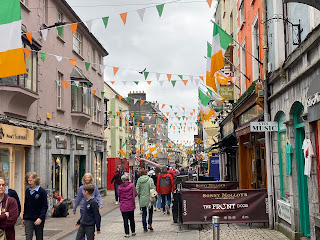After a second day in front of a computer at the ScotlandsPeople Record Centre, I have developed a sore throat.
No that is not the announcement. Regardless of discomfort I walked to the Dalkeith Local Studies Centre, which is open to 7pm on a Thursday. Two objectives - find Esbank Lodge, where a Buchan girl was a servant to a local banker. Secondly look at burial records or monument inscriptions in search of where the Robert Buchan who died in a mining accident at the age of 74 is buried, somewhere in Newbattle Parish. He died in 1887, and because there is an Old and New Newbattle Cemetery which opened in 1813, I didn’t know where he was buried. There is one major deficiency with Scottish records - they don’t include the burial location.
As it happened I walked down a new road today on the way to the train. Close readers of this blog know that the Newbattle Cemetery is quite close to the station, but it has been raining every time I arrived back from Edinburgh.
I photographed a rather posh gateway, with unicorns, along the way - hey that WAS Esbank Lodge, it is now a housing estate but the gates remain. A asked a man walking his elderly dogs were the Lodge was, hoping it was a well-known building. Apparently not, but the librarian found it on the internet.
I followed the road to the New Cemetery. Lots of graves, probably loads of relatives with new names I did not prepare to look for. I knew there were no Buchan monuments in that cemetery from online sources. There was a gate, that seemed to enter a new world, one that was unmowed, wild, abandoned.
 |
| Into the wild wood |
This was the path to the old cemetery. I tried to pull aside any ivy or moss to be sure there was no Buchan hidden there.
 |
| A re-made plaque for the very un-Scot sounding Junkison and Romans families. |
But no luck. My shoes were saturated, and my sox, and my trouser legs, because the heavy rain and the above knee grass all had contributed to allow the water to cling to me.
Never mind, I was off to Edinburgh, trying to follow a Google path on my phone (many people know I am pretty hopeless with directions). So I asked an elderly gent who was heading in the right direction, to just confirm my choice at a fork. Well he was a Scot who lived nearby, but he had also lived in Australia for 52 years, coming home to be near two children. In fact he had visitors from the Blue Mountains staying - would I like to come to see Dalkeith Palace? How nice, but I was already booked elsewhere.
So later in the day, in the Local Studies Centre, in the Monumental Inscriptions book for Old Newbattle Cemetery, I found that Robert was buried in Section 7. I had walked over the area unknowingly. I doubt there is a marker, but he is there. Sadly there is no record of his father George’s burial in 1818 or his mother Jean’s in 1849 - but I expect they are nearby.
He is in 7/12, and the book had a map to guide me when I go back. It is just a few hundred metres up the road from Fawlty Towers.
Tomorrow I am meeting up with Helen. She is the lady who believed that this same Robert Buchan married her ancestor, but she could never find him anywhere. In my exuberance in the DNA course, and with Michele Leonard as my coach, I found Helen’s ancestor born illegitimately in a minor church, called the Leith Relief Church in 1835. Possibly just one year after my ancestor Robert who emigrated to Australia in 1852; the two were half siblings.
So this man, whose resting place has been found, didn’t acknowledge the daughter, Jane Drysdale, and her mother married a sailor in 1837. [Note - I have always taken this to indicate that he was still married to Janet McRae]. Leith is the Port of Edinburgh. I hope to go there on Saturday. So Jane is on the 1841 census under her step-father’s surname. Her mother died of cholera in 1848. In the 1851 census, she is now called Jane Drysdale Buchan, now living with her maternal grandmother, still in Leith. From this time forward, she includes the surname Buchan on all her documents, and even begins a tradition of giving Buchan as a middle name that continued down to Helen’s own mother! It must mean she cared!
Tomorrow we plan to visit the cemetery again, visit homes of Robert and his wife Margaret, in Newtongrange and Lothian Bridge, and pop along to both the Abbey and Palace, and I hope the Mining Museum. Helen has never been to any of these places. She lives 30 minutes away, so we’ll have a nice half day out together. Helen and I are half fourth cousins. I share 35cM with her, pretty healthy, but my brother Peter shares 98cM with her, which is off the charts.

























































